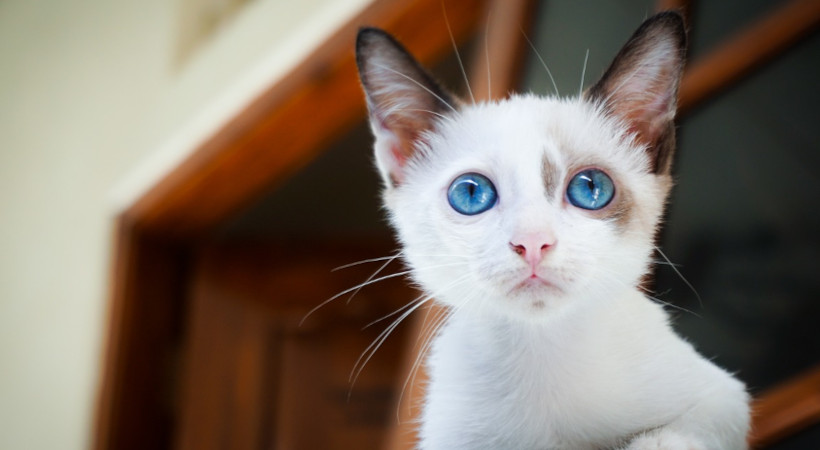Wondering why your feline friend is vomiting? Wanting some top tips on what can help and when veterinary treatment is recommended? We take a look at the main reasons why cats vomit and when you should be concerned.
It’s not a particularly nice topic, but one many cat owners struggle with – the evidence of a mess on the carpet that your kitty has been sick. So, what are the main reasons why cats vomit, and what can help prevent this?
Vomiting Can Be a Cause for Concern
The most important thing is to understand that continuous vomiting is of concern. Any cat who is frequently vomiting should be seen quickly by a qualified veterinarian to rule out any underlying conditions that could be causing your cat to be sick.
Vomiting can also lead to dehydration and be a strong indication that something is not right. As a general rule, a cat who is vomiting up to twice a day, for more than two to three days needs to be seen by a veterinarian.
Other indications that warrant further investigation are:
- Constant retching
- Blood in the vomit
- Stomach pains
- Decrease in appetite
- Unusual behaviors
Related: Can Cats Catch the Flu or Colds?
Why Do Cats Vomit?
If your cat is being sick a few times per month, this is considered normal by many in the profession, or ‘acute vomiting’. It can be caused by a host of reasons that in some cases can be completely preventable.
Hairballs
Many long-haired, and short haired breeds will vomit after a good grooming session. Hairballs are normally the culprit for this. It’s a good plan to start a grooming regime for your cat. Having the brush handy for when you are having a night-time snuggle is a great way to allow your cat the pleasure of grooming while also preventing hairballs and reducing sickness episodes due to hair. Grooming can also strengthen the bond between you and your feline friend.
If you have never groomed your cat before, start with short sessions and gradually increase. Rubber grooming mitts are perfect for short haired breeds, while long-haired breeds and double-coated cats will require the use of a slicker brush and a comb. Regular grooming can also prevent painful mats and tangles.
The Over Indulger
Another main reason why cats vomit is eating too much, too quickly. Surprisingly this is one of the top reasons for cats vomiting. If your cat is being sick after eating a meal, or complete biscuits are being left as a mess, it’s a good idea to try and slow your cat down when they are enjoying a meal.
A simple trick is to add a ball into their dish or choose to feed your pet smaller meals rather than one large meal. Ensure the ball is not small enough for your cat to swallow. A good rule is to use a larger cat ball-toy. This will cause Fluffy to push and roll the ball out of the way so they can access their food.
Another reason why your cat could be gulping down the food at an exponential pace could be due to competition with other cats in the household. If you do have a multi-cat home, having additional eating stations can help. If you are feeding wet food, consider feeding each cat at different times of the day. If you notice that your cat is not chewing their food, and swallowing biscuits whole, a teeth check may be in order and a switch to softer foods (particularly with older felines).
The Curious Nibbler
Some cats also vomit from eating grass and other materials such as tissues or toilet paper. This is a natural way for your cat to remove the unwanted material that is sitting inside their stomach. This curiosity can cause issues, particularly if your cat ingests string, a small toy, or a toxic plant such as lilies.
If you have a cat it is advisable to not have any type of lily in your home. Lilly posing can lead to acute kidney failure in cats. All parts of the lily plant are toxic to cats and that includes the stem, leaves, and roots – even licking the pollen off their coat can result in poisoning. Within two hours of ingestion, vomiting, lethargy, and lack of appetite can occur.
As the acute kidney damage develops, cats will show signs of weakness, drooling, drinking, urinating more often, tremors, and even seizures. It is vital if you notice any of these symptoms in your cat to seek veterinary treatment quickly. If you do have a curious nibbler, consider planting specially formulated cat grass, having a good selection of cat toys, and keeping the poisonous plants away from the home.
Diet
If you are struggling with your cat’s vomiting it might be worth asking your vet about a diet change. Many top-quality brands can help with digestion issues. If you are considering a diet change remember to do this very gradually or you may escalate the vomiting and tummy upsets.
Final Thoughts
Vomiting is not nice for the feline or the owner, so if this is a regular occurrence in your household (more than three times per month), it’s best to visit a vet, as this could indicate something more serious than the above, including:
- Parasites
- Inflammatory bowel disease
- Constipation
- Cancer
- Ulceration
- Pancreatitis
- Kidney disease
- Liver disease
- Diabetes mellitus
- Feline infectious peritonitis
- Neurologic diseases
If, however, your kitty is just sick once in a while, use the above points to work out what the cause could be and try to prevent it in future.

Related Articles:








